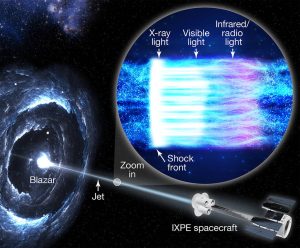Scientists Use X-Rays to Solve Mystery Around Blazars
When a black hole feeds on material, it can whip up enormous jets of matter that stream out from the black hole at an angle that is perpendicular to the accretion disk around it. When one of the jets is pointed toward Earth – or at least close enough that an orbiting observatory can observe it – it becomes one of the brightest objects in the night sky. Scientists call it a blazar due to the high-energy particles blasting outward from it.
One mystery surrounding blazars involves how a feeding black hole can accelerate the matter in the jets to such high speeds. Now a research team says it solved that mystery using NASA’s Imaging X-Ray Polarimetry Explorer (IXPE) to measure the X-ray emissions coming from a blazar in the constellation Hercules.
“This is a 40-year-old mystery that we’ve solved,” said Yannis Liodakis, lead author of the study published in the journal Nature and astronomer at FINCA, the Finnish Centre for Astronomy with ESO.
The IXPE is a relatively new satellite that launched on December 9, 2021 on one of SpaceX’s rockets. It can measure the polarization of X-rays, giving scientists valuable data on their direction and intensity of the X-ray light waves’ electric field. Ground-based telescopes can’t produce the same data because Earth’s atmosphere absorbs most X-rays.
“The first X-ray polarization measurements of this class of sources allowed, for the first time, a direct comparison with the models developed from observing other frequencies of light, from radio to very high-energy gamma rays,” said Immacolata Donnarumma, the project scientist for IXPE at the Italian Space Agency. “IXPE will continue to provide new evidence as the current data is analyzed and additional data is acquired in the future.”

For this study, IXPE was pointed at a blazar at the center of a large elliptical galaxy in the constellation Hercules. It watched the blazar, named Markarian 501, for three days in early March 2022 and then made more observations of Markarian 501 two weeks later. Other telescopes in space and on the ground observed the same blazar using other frequencies like radio and infrared during the same time period.
X-ray data was especially valuable for this study because it is emitted closer to the source of the particle acceleration. This allowed scientists to determine that most of the rapid acceleration close to the black hole comes from a shock wave similar to the “sonic boom” that is generated when a jet plane moves faster than the speed of sound on Earth.
“As the shock wave crosses the region, the magnetic field gets stronger, and energy of particles gets higher,” Marscher said. “The energy comes from the motion energy of the material making the shock wave.”
The researchers did not have enough data to determine the origin of the shock wave. However, they could determine that it provided enough of the initial energy to cause them to emit X-rays. Then, as they move away and start to lose energy, they emit light at lower frequencies like optical, radio, and infrared light.
The researchers are planning future observations to see if the polarization of the X-rays changes over time. The IXPE team is also planning to have it observe other blazars during the remainder of its two-year prime mission.





